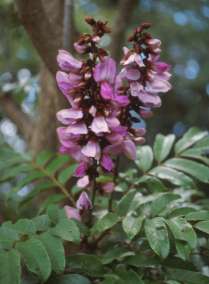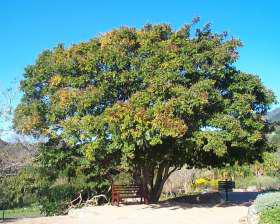Millettia grandis
Millettia grandis (E.Mey.) Skeels
Family: Fabaceae
Common names: umzimbeet (Eng.); umsambeet (Afr.); umSimbithwa (Zulu) umKunye (Xhosa)
SA Tree No: 227
Introduction
This is an attractive shade tree which can also be grown as a specimen tree to display its grey bark, coppery red young leaves and flower buds, lilac to purple flowers and golden pods.

Description
Description
A semi-deciduous tree up to 25 m tall with a spreading crown in good conditions, but much smaller in shallow soils.

Bark is smooth and grey brown on younger branches, flaky when older. Compound leaves have 3-7 pairs of opposite, lance-shaped leaflets and are up to 250 mm long overall; glossy dark green or blue green on top with fine silky hairs on the underside. The tree is semi-deciduous. New leaves and petioles (leaf stalks) are reddish and velvety.
The attractive flowers which occur in summer are pea-shaped, mauve to purple and held in an upright inflorescence on the ends of the branches.They emerge from rusty brown buds which are formed in spring.
The fruits are flat, woody pods covered with a thick layer of golden brown hairs, held erect, splitting when dry to release flat, oblong seeds; valves spiralling when dry.


This tree has yellow sapwood and very heavy, hard and reddish to dark brown heartwood.
Distribution and habitat
Distribution description
Umzimbeet has a restricted, disjunct distribution in Kwa-Zulu Natal and the Eastern Cape. It is most common in Pondoland.
Derivation of name and historical aspects
History
Millettia is named after Charles Millet of Canton, China (circa 1830) and grandis means large.
Uses
Use
Umzimbeet's hard wood with its attractive coloration is valued for the manufacture of furniture and small domestic implements. Today it is used for making tough, bicoloured walking sticks which are sold to tourists.
It can also be used as a windbreak and harvested at 10-15 years for planks in high-rainfall areas. It also makes an attractive garden and street tree and it does not have an aggressive root system.
It can be planted along pastures and fence lines to act as a windbreak and as shelters for animals. The stems are easily cut into planks when fresh. The only animals to utilize the plants are baboons who strip and eat the bark, and some butterflies whose larvae feed on the pods.
The powdered root can be used as a fish poison, but fish must be boiled before consumption. The ground seed soaked in milk is used as a remedy for roundworm, but with caution as consuming too many seeds is poisonous. It is reported that a mixture of roots with those of Croton species with one part of lion fat and one part of python fat is burnt in the house as a tranquilizer to dispel worries; other recipes exist for sleep-inducing cures based on the roots. Ground seed can be used as an arrow poison.

Growing Millettia grandis
Grow
This tree is usually grown from fresh seed which must be placed in hot water to soak overnight. Fresh seed germinates very well. Plant seedlings into nursery bags at the two-leaf stage. Young trees will transplant easily and they are fast growing (0.8 to 1 m per year) in favourable conditions. This tree likes ample water and can withstand several degrees of frost, particularly when older. It makes a very shapely, attractive specimen with seasonal interest for the garden.
References
- Coates Palgrave, M. 2002. Keith Coates Palgrave Trees of southern Africa, edn 3. Struik, Cape Town.
- Hutchings, A. 1996. Zulu medicinal plants. University of Natal Press, Pietermaritzburg.
- Joffe, P. 1993. The gardener's guide to South African plants. Tafelberg, Cape Town.
- Palmer, E. & Pitman, N. 1972. Trees of southern Africa. Balkema, Cape Town.
- Venter, F. & Venter, J.A. 1996. Making the most of indigenous trees. Briza Publications, Pretoria.
Credits
K. J. Baloyi & Yvonne Reynolds
Pretoria National Botanical Garden
August 2004
Plant Attributes:
Plant Type: Tree
SA Distribution: Eastern Cape, KwaZulu-Natal
Soil type: Sandy, Loam
Flowering season: Early Summer, Late Summer
PH: Acid, Neutral
Flower colour: Purple, Mauve/Lilac
Aspect: Full Sun
Gardening skill: Average
Special Features:
Horticultural zones











Rate this article
Article well written and informative
Rate this plant
Is this an interesting plant?
Login to add your Comment
Back to topNot registered yet? Click here to register.